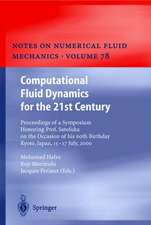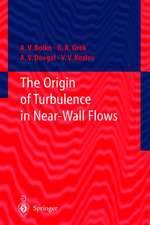Melt Rheology and Its Role in Plastics Processing: Theory and Applications
Autor John M. Dealy, K.F. Wissbrunen Limba Engleză Paperback – 31 iul 1999
Preț: 963.47 lei
Preț vechi: 1174.96 lei
-18% Nou
Puncte Express: 1445
Preț estimativ în valută:
184.36€ • 192.48$ • 152.58£
184.36€ • 192.48$ • 152.58£
Carte tipărită la comandă
Livrare economică 04-18 aprilie
Preluare comenzi: 021 569.72.76
Specificații
ISBN-13: 9780792358862
ISBN-10: 0792358864
Pagini: 680
Ilustrații: 680 p. 4 illus.
Dimensiuni: 155 x 235 x 36 mm
Greutate: 0.96 kg
Ediția:1999
Editura: SPRINGER NETHERLANDS
Colecția Springer
Locul publicării:Dordrecht, Netherlands
ISBN-10: 0792358864
Pagini: 680
Ilustrații: 680 p. 4 illus.
Dimensiuni: 155 x 235 x 36 mm
Greutate: 0.96 kg
Ediția:1999
Editura: SPRINGER NETHERLANDS
Colecția Springer
Locul publicării:Dordrecht, Netherlands
Public țintă
ResearchCuprins
1. Introduction to Rheology.- 1.1 What is Rheology?.- 1.2 Why Rheological Properties are Important.- 1.3 Stress as a Measure of Force.- 1.4 Strain as a Measure of Deformation.- 1.4.1 Strain Measures for Simple Extension.- 1.4.2 Shear Strain.- 1.5 Rheological Phenomena.- 1.5.1 Elasticity; Hooke’s Law.- 1.5.2 Viscosity.- 1.5.3 Viscoelasticity.- 1.5.4 Structural Time Dependency.- 1.5.5 Plasticity and Yield Stress.- 1.6 Why Polymeric Liquids are Non-Newtonian.- 1.6.1 Polymer Solutions.- 1.6.2 Molten Plastics.- 1.7 A Word About Tensors.- 1.7.1 Vectors.- 1.7.2 What is a Tensor?.- 1.8 The Stress Tensor.- 1.9 A Strain Tensor for Infinitesimal Deformations.- 1.10 The Newtonian Fluid.- 1.11 The Basic Equations of Fluid Mechanics.- 1.11.1 The Continuity Equation.- 1.11.2 Cauchy’s Equation.- 1.11.3 The Navier-Stokes Equation.- References.- 2. Linear Viscoelasticity.- 2.1 Introduction.- 2.2 The Relaxation Modulus.- 2.3 The Boltzmann Superposition Principle.- 2.4 Relaxation Modulus of Molten Polymers.- 2.5 Empirical Equations for the Relaxation Modulus.- 2.5.1 The Generalized Maxwell Model.- 2.5.2 Power Laws and an Exponential Function.- 2.6 The Relaxation Spectrum.- 2.7 Creep and Creep Recovery; The Compliance.- 2.8 Small Amplitude Oscillatory Shear.- 2.8.1 The Complex Modulus and the Complex Viscosity.- 2.8.2 Complex Modulus of Typical Molten Polymers.- 2.8.3 Quantitative Relationships between G*(?) and MWD.- 2.8.4 The Storage and Loss Compliances.- 2.9 Determination of Maxwell Model Parameters.- 2.10 Start-Up and Cessation of Steady Simple Shear and Extension.- 2.11 Molecular Theories: Prediction of Linear Behavior.- 2.11.1 The Modified Rouse Model for Unentangled Melts.- 2.11.1.1 The Rouse Model for Dilute Solutions.- 2.11.1.2 The Bueche Modification of the Rouse Theory.-2.11.1.3 The Bueche-Ferry Law.- 2.11.2 Molecular Theories for Entangled Melts.- 2.11.2.1 Evidence for the Existence of Entanglements.- 2.11.2.2 The Nature of Entanglement Coupling.- 2.11.2.3 Reptation.- 2.11.2.4 The Doi-Edwards Theory.- 2.11.2.5 The Curtiss-Bird Model.- 2.11.2.6 Limitations of Reptation Models.- 2.12 Time-Temperature Superposition.- 2.13 Linear Behavior of Several Polymers.- References.- 3. Introduction to Nonlinear Viscoelasticity.- 3.1 Introduction.- 3.2 Nonlinear Phenomena.- 3.3 Theories of Nonlinear Behavior.- 3.4 Finite Measures of Strain.- 3.4.1 The Cauchy Tensor and the Finger Tensor.- 3.4.2 Strain Tensors.- 3.4.3 Reference Configurations.- 3.4.4 Scalar Invariants of the Finger Tensor.- 3.5 The Rubberlike Liquid.- 3.5.1 A Theory of Finite Linear Viscoelasticity.- 3.5.2 Lodge’s Network Theory and the Convected Maxwell Model.- 3.5.3 Behavior of the Rubberlike Liquid in Simple Shear Flows.- 3.5.3.1 Rubberlike Liquid in Step Shear Strain.- 3.5.3.2 Rubberlike Liquid in Steady Simple Shear.- 3.5.3.3 Rubberlike Liquid in Oscillatory Shear.- 3.5.3.4 Constrained Recoil of Rubberlike Liquid.- 3.5.3.5 The Stress Ratio (N1/?) and the Recoverable Shear.- 3.5.4 The Rubberlike Liquid in Simple Extension.- 3.5.5 Comments on the Rubberlike Liquid Model.- 3.6 The BKZ Equation.- 3.7 Wagner’s Equation and the Damping Function.- 3.7.1 Strain Dependent Memory Function.- 3.7.2 Determination of the Damping Function.- 3.7.3 Separable Stress Relaxation Behavior.- 3.7.4 Damping Function Equations for Polymeric Liquids.- 3.7.4.1 Damping Function for Shear Flows.- 3.7.4.2 Damping Function for Simple Extension.- 3.7.4.3 Universal Damping Functions.- 3.7.5 Interpretation of the Damping Function in Terms of Entanglements.- 3.7.5.1 The Irreversibility Assumption.- 3.7.6Comments on the Use of the Damping Function.- 3.8 Molecular Models for Nonlinear Viscoelasticity.- 3.8.1 The Doi-Edwards Constitutive Equation.- 3.9 Strong Flows; The Tendency to Stretch and Align Molecules.- References.- 4. Steady Simple Shear Flow and the Viscometric Functions.- 4.1 Introduction.- 4.2 Steady Simple Shear Flow.- 4.3 Viscometric Flow.- 4.4 Wall Slip and Edge Effects.- 4.5 The Viscosity of Molten Polymers.- 4.5.1 Dependence of Viscosity on Shear Rate.- 4.5.2 Dependence of Viscosity on Temperature.- 4.6 The First Normal Stress Difference.- 4.7 Empirical Relationships Involving Viscometric Functions.- 4.7.1 The Cox-Merz Rules.- 4.7.2 The Gleissle Mirror Relations.- 4.7.3 Other Relationships.- References.- 5. Transient Shear Flows Used to Study Nonlinear Viscoelasticity.- 5.1 Introduction.- 5.2 Step Shear Strain.- 5.2.1 Finite Rise Time.- 5.2.2 The Nonlinear Shear Stress Relaxation Modulus.- 5.2.3 Time-Temperature Superposition.- 5.2.4 Strain-Dependent Spectrum and Maxwell Parameters.- 5.2.5 Normal Stress Differences for Single-Step Shear Strain.- 5.2.6 Multistep Strain Tests.- 5.3 Flows Involving Steady Simple Shear.- 5.3.1 Start-Up Flow.- 5.3.2 Cessation of Steady Simple Shear.- 5.3.3 Interrupted Shear.- 5.3.4 Reduction in Shear Rate.- 5.4 Nonlinear Creep.- 5.4.1 Time-Temperature Superposition of Creep Data.- 5.5 Recoil and Recoverable Shear.- 5.5.1 Creep Recovery.- 5.5.1.1 Time-Temperature Superposition; Creep Recovery.- 5.5.2 Recoil During Start-Up Flow.- 5.5.3 Recoverable Shear Following Steady Simple Shear.- 5.6 Superposed Deformations.- 5.6.1 Superposed Steady and Oscillatory Shear.- 5.6.2 Step Strain with Superposed Deformations.- 5.7 Large Amplitude Oscillatory Shear.- 5.8 Exponential Shear; A Strong Flow.- 5.9 Usefulness of Transient Shear Tests.- References.- 6. Extensional Flow Properties and Their Measurement.- 6.1 Introduction.- 6.2 Extensional Flows.- 6.3 Simple Extension.- 6.3.1 Material Functions for Simple Extension.- 6.3.2 Experimental Methods.- 6.3.3 Experimental Observations for LDPE.- 6.3.4 Experimental Observations for Linear Polymers.- 6.4 Biaxial Extension.- 6.5 Planar Extension.- 6.6 Other Extensional Flows.- References.- 7. Rotational and Sliding Surface Rheometers.- 7.1 Introduction.- 7.2 Sources of Error for Drag Flow Rheometers.- 7.2.1 Instrument Compliance.- 7.2.2 Viscous Heating.- 7.2.3 End and Edge Effects.- 7.2.4 Shear Wave Propagation.- 7.3 Cone-Plate Flow Rheometers.- 7.3.1 Basic Equations for Cone-Plate Rheometers.- 7.3.2 Sources of Error for Cone-Plate Rheometers.- 7.3.3 Measurement of the First Normal Stress Difference.- 7.4 Parallel Disk Rheometers.- 7.5 Eccentric Rotating Disks.- 7.6 Concentric Cylinder Rheometers.- 7.7 Controlled Stress Rotational Rheometers.- 7.8 Torque Rheometers.- 7.9 Sliding Plate Rheometers.- 7.9.1 Basic Equations for Sliding Plate Rheometers.- 7.9.2 End and Edge Effects for Sliding Plate Rheometers.- 7.9.3 Sliding Plate Melt Rheometers.- 7.9.4 The Shear Stress Transducer.- 7.10 Sliding Cylinder Rheometers.- References.- 8. Flow in Capillaries, Slits and Dies.- 8.1 Introduction.- 8.2 Flow in a Round Tube.- 8.2.1 Shear Stress Distribution.- 8.2.2 Shear Rate for a Newtonian Fluid.- 8.2.3 Shear Rate for a Power Law Fluid.- 8.2.4 The Rabinowitch Correction.- 8.2.5 The Schümmer Approximation.- 8.2.6 Wall Slip in Capillary Flow.- 8.3 Flow in a Slit.- 8.3.1 Basic Equations for Shear Stress and Shear Rate.- 8.3.2 Use of a Slit Rheometer to Determine N1.- 8.3.2.1 Determination of N1 from the Hole Pressure.- 8.3.2.2 Determination of N1 from the Exit Pressure.- 8.4Pressure Drop in Irregular Cross Sections.- 8.5 Entrance Effects.- 8.5.1 Experimental Observations.- 8.5.2 Entrance Pressure Drop—the Bagley End Correction.- 8.5.3 Rheological Significance of the Entrance Pressure Drop.- 8.6 Capillary Rheometers.- 8.7 Flow in Converging Channels.- 8.7.1 The Lubrication Approximation.- 8.7.2 Industrial Die Design.- 8.8 Extrudate Swell.- 8.9 Extrudate Distortion.- 8.9.1 Surface Melt Fracture—Sharkskin.- 8.9.2 Oscillatory Flow in Linear Polymers.- 8.9.3 Gross Melt Fracture.- 8.9.4 Role of Slip in Melt Fracture.- 8.9.5 Gross Melt Fracture Without Oscillations.- References.- 9. Rheo-Optics and Molecular Orientation.- 9.1 Basic Concepts—Interaction of Light and Matter.- 9.1.1 Refractive Index and Polarization.- 9.1.2 Absorption and Scattering.- 9.1.3 Anisotropic Media; Birefringence and Dichroism.- 9.2 Measurement of Birefringence.- 9.3 Birefringence and Stress.- 9.3.1 Stress-Optical Relation.- 9.3.2 Application of Birefringence Measurements.- References.- 10. Effects of Molecular Structure.- 10.1 Introduction and Qualitative Overview of Molecular Theory.- 10.2 Molecular Weight Dependence of Zero Shear Viscosity.- 10.3 Compliance and First Normal Stress Difference.- 10.4 Shear Rate Dependence of Viscosity.- 10.5 Temperature and Pressure Dependence.- 10.5.1 Temperature Dependence of Viscosity.- 10.5.2 Pressure Dependence of Viscosity.- 10.6 Effects of Long Chain Branching.- References.- 11. Rheology of Multiphase Systems.- 11.1 Introduction.- 11.2 Effect of Rigid Fillers.- 11.2.1 Viscosity.- 11.2.2 Elasticity.- 11.3 Deformable Multiphase Systems (Blends, Block Polymers).- 11.3.1 Deformation of Disperse Phases and Relation to Morphology.- 11.3.2 Rheology of Immiscible Polymer Blends.- 11.3.3 Phase-Separated Block and Graft Copolymers.-References.- 12. Chemorheology of Reacting Systems.- 12.1 Introduction.- 12.2 Nature of the Curing Reaction.- 12.3 Experimental Methods for Monitoring Curing Reactions.- 12.3.1 Dielectric Analysis.- 12.4 Viscosity of the Pre-gel Liquid.- 12.5 The Gel Point and Beyond.- References.- 13. Rheology of Thermotropic Liquid Crystal Polymers.- 13.1 Introduction.- 13.2 Rheology of Low Molecular Weight Liquid Crystals.- 13.3 Rheology of Aromatic Thermotropic Polyesters.- 13.4 Relation of Rheology to Processing of Liquid Crystal Polymers.- References.- 14. Role of Rheology in Extrusion.- 14.1 Introduction.- 14.1.1 Functions of Extruders.- 14.1.2 Types of Extruders.- 14.1.3 Screw Extruder Zones.- 14.2 Analysis of Single Screw Extruder Operation.- 14.2.1 Approximate Analysis of Melt Conveying Zone.- 14.2.2 Coupling Melt Conveying to Die Flow.- 14.2.3 Effects of Simplifying Approximations.- 14.2.3.1 Geometric Factors.- 14.2.3.2 Leakage Flow.- 14.2.3.3 Non-Newtonian Viscosity.- 14.2.3.4 Non-Isothermal Flow.- 14.2.4 Solids Conveying and Melting Zones.- 14.2.4.1 Feeding and Solids Conveying.- 14.2.4.2 Melting Zone.- 14.2.5 Scale-Up and Simulation.- 14.2.5.1 Scale-Up.- 14.2.5.2 Simulation.- 14.3 Mixing, Devolatilization and Twin Screw Extruders.- 14.3.1 Mixing.- 14.3.2 Devolatilization.- 14.3.3 Twin Screw Extruders.- References.- 15. Role of Rheology in Injection Molding.- 15.1 Introduction.- 15.2 Melt Flow in Runners and Gates.- 15.3 Flow in the Mold Cavity.- 15.4 Laboratory Evaluation of Molding Resins.- 15.4.1 Physical Property Measurement.- 15.4.2 Moldability Tests.- 15.5 Formulation and Selection of Molding Resins.- References.- 16. Role of Rheology in Blow Molding.- 16.1 Introduction.- 16.2 Flow in the Die.- 16.3 Parison Swell.- 16.4 Parison Sag.- 16.4.1 Pleating.- 16.5 Parison Inflation.- 16.6 Blow Molding of Engineering Resins.- 16.7 Stretch Blow Molding.- 16.8 Measurement of Resin Processability.- 16.8.1 Resin Selection Tests.- 16.8.2 Quality Control Tests.- References.- 17. Role of Rheology in Film Blowing and Sheet Extrusion.- 17.1 The Film Blowing Process.- 17.1.1 Description of the Process.- 17.1.2 Criteria for Successful Processing.- 17.1.3 Principal Problems Arising in Film Blowing.- 17.1.4 Resins Used for Blown Film.- 17.2 Flow in the Extruder and Die; Extrudate Swell.- 17.3 Melt Flow in the Bubble.- 17.3.1 Forces Acting on the Bubble.- 17.3.1.1 Viscous Stress in the Molten Region of the Bubble.- 17.3.1.2 Aerodynamic Forces.- 17.3.2 Bubble Shape.- 17.3.3 Drawability.- 17.4 Bubble Stability.- 17.5 Sheet Extrusion.- References.- 18. On-Line Measurement of Rheological Properties.- 18.1 Introduction.- 18.2 Types of On-Line Rheometers for Melts.- 18.2.1 On-Line Capillary Rheometers for Melts.- 18.2.2 Rotational On-Line Rheometers for Melts.- 18.2.3 In-Line Melt Rheometers.- 18.3 Specific Applications of Process Rheometers.- References.- 19. Industrial Use of Rheometers.- 19.1 Factors Affecting Test and Instrument Selection.- 19.1.1 Purposes of Rheological Testing.- 19.1.2 Material Limitations on Test Selection.- 19.1.3 Instruments.- 19.2 Screening and Characterization.- 19.2.1 Advantages and Disadvantages of Rheological Tests.- 19.2.2 Other Information Useful for Screening.- 19.2.3 Stability.- 19.2.3.1 Stability Measurement.- 19.2.3.2 Use of Stability Data.- 19.2.4 Temperature and Frequency Dependence.- 19.2.4.1 Measurement Tactics.- 19.2.4.2 Interpretation of Results.- 19.3 Resin Selection and Optimization and Process Problem Solving.- 19.4 Rheological Quality Control Tests.- References.- Appendix A: Measures of Strain for Large Deformations.- Appendix B: Molecular Weight Distribution and Determination of Molecular Weight Averages.- Appendix C: The Intrinsic Viscosity and The Inherent Viscosity.- Appendix D: The Glass Transition Temperature.- Appendix E: Manufacturers of Melt Rheometers and Related Equipment.- Nomenclature.- Author Index.
















